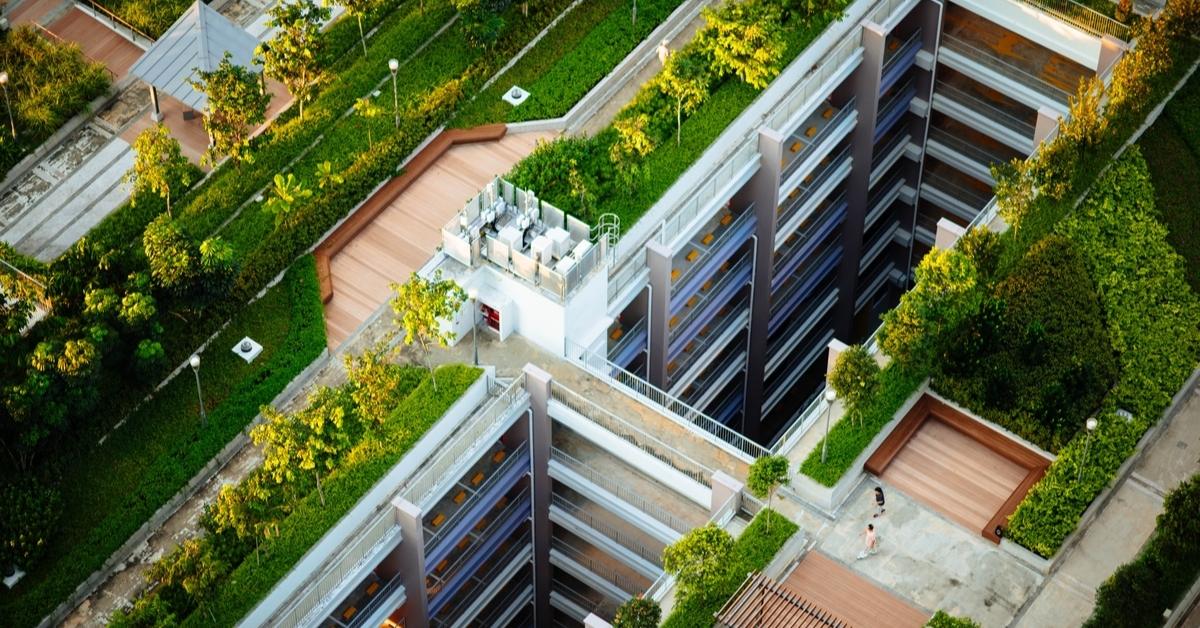Historically, green roofs have been built in various parts of the world and in various climate zones.
The reasons for their use: guaranteeing waterproofing and protection from the wind and temperature changes on building roofs.
Green roofing
The term “roofing a building” designates an element that forms part of the building’s envelope. Its characterisation as “green” implies a change to the very structure of the roof, but also confers specific requirements and performance, depending on its structure.
Green roofs can be divided into two categories:
- extensive green roof,
- intensive green roof.
In practice, this categorisation helps distinguish the volume and weight of the green roof’s layers, the type of vegetation that can be planted, the maintenance required.
Extensive green roof
Extensive green roofs are the simplest to build and are characterised by nearly autonomous maintenance.
The green space installed in this GreenROOF system co-engineered with ISOPAN-DAKU has a good propagation and self-regeneration ability. It is built using vegetation that resists even to extreme temperatures and short dry periods.
The thickness of the growth medium is limited to a few centimetres; the weight of a square metre of the stratigraphy is also lower than other types of green roofs. The load ranges from 80 to 150 kg/m2.
Maintenance is reduced to a minimum; in general, only two operations a year are required to control the system, check the status of the vegetation, possibly pull out weeds, and free the drains.
These features make it an easy-to-implement solution, also in the case of building redevelopment, where the load-bearing structures have not been designed specifically to support larger loads.
It is used to improve the performance of the roofing and for environmental mitigation.
The most used vegetation is sedum, a succulent of the Crassulaceae family, which is naturally very common, found at various latitudes and climatic conditions. It is also possible to choose other types of plants, such as grass. However, although the thickness of the stratigraphy does not change, certain types of grass require irrigation, fertilisation, cutting and more frequent monitoring, thus increasing scheduled maintenance costs.
Semi-intensive and intensive green roof
When we think of semi-intensive or intensive green roofs, we would be right to imagine actual gardens, where the vegetation can be chosen in absolute freedom, as if they were intended for the soil: grass, plants, bushes, trees. In this case, the right name is actually “hanging garden”.
Aside from operations intended to control the system’s elements, there is mowing the grass, pruning, and all the typical activities of a traditional garden, including watering. This necessarily entails a higher cost compared to an extensive roof during the building’s life.
The thickness of the growth medium must be proportional to the plants’ needs. The load increases and can reach notable peaks if shrubs and trees are planted.
Green roof to perfection
For the correct stratigraphy used to build a green roof, reference can be made to the standard UNI 11235 “Criteria for design, execution, testing and maintenance of roof gardens”.
UNI 11235 standard
The standard helps design, install and maintain green roofs. It provides instructions on the stratigraphy, from the all-important waterproofing anti-root layer, which guarantees the traditional function of the roof as cover, to the recommended vegetation, depending on the type of green roofs (extensive or intensive).
The standard provides exact references to the thickness required for the various types of green roofs.
An 8 cm substrate may be sufficient for an extensive green roof, while, in the intensive type, this substrate starts at 15 cm and increases depending on the needs. In both cases, the substrate is governed by the standard and must have precise chemical/physical and grading curve features. It is a compound of mixes of natural mineral elements and a minimum fraction of organic matter.
All instructions provided by the standard serve as operating guidelines to avoid errors, which could be all-important. The most delicate aspect is the installation of the various layers. The first is the waterproof layer, which is the lowest and forms the base on which to build the rest of the functional stratigraphy.
The text also provides a reference point to measure the green roof performance with precise and defined references.


